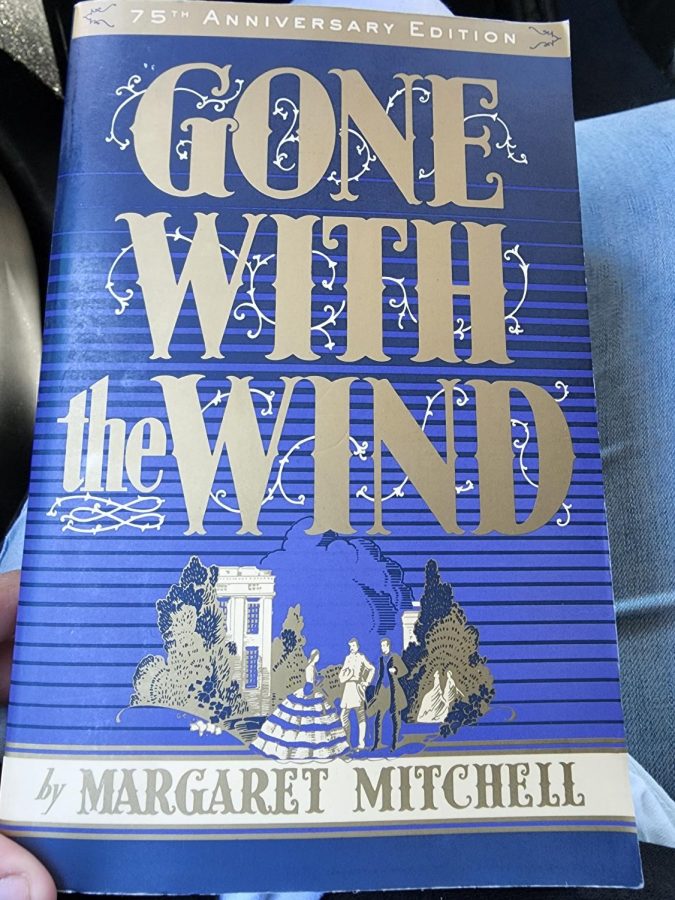Review: Gone with the Wind, the Novel
Is it worth reading this controversial, banned book? This reporter explores the subject, giving an overview of what it’s about.
Gone with the Win, clocking in at 1037 pages.
September 26, 2022
Gone with the Wind is being pulled from the shelves of American schools and libraries and one can see why. The book was written in a time when racism was still rife and it involves slavery as told from a white southern perspective. Therefore, the book includes derogatory terms towards African Americans and it portrays some of the enslaved characters as “happy,” when slavery was anything but.
Which is clear to see why, with its numerous terms, portrayals and depictions the book has become notorious as an emblem of racism. But if you are willing to read this book even with its outdated views, Gone with the Wind is a story that’s worth a read.
The only novel of the journalist and novelist Margaret Mitchell, “Gone with the Wind” is a historical fiction novel that takes place during the American Civil War and the Reconstruction era of the South after the war. The day I got the book, I began to read it and immediately became engrossed in it.
Gone with the Wind is 1,037 pages long with a total of sixty-three chapters divided into five parts. The story begins in the Spring of 1861 with the Tarleton twins Brent and Stuart. Upon being told by them that Ashley Wilkes, a boy in her county, is to marry a distant relative of his, Melanie Hamilton, Scarlett, the protagonist, is heart broken. In her mind, Ashley had to be in love with her. Upon her confrontation towards him at his family’s plantation, he marries Melanie anyway. Scarlett, in order to make Ashley jealous, marries Charles Hamilton, Melanie’s brother. Having done this, the Civil War begins and unfortunately, not even into a year of marriage, Charles is killed. Being a widow in mourning and with her emotions everywhere, Scarlett moves to Atlanta with Charles Aunt Pittypat and Melanie. From then on, the life of Scarlett O’Hara continues and alters in more ways than one.
From then on, the plot follows Scarlett O’Hara from the time during the Civil War and the South’s Reconstruction era which are both full of struggle and hardship. It’s a story of unrequited love, hardship, and watching the life you once lived leave and the people you once knew either die in war or become the ghost of what they used to be. Scarlett O’Hara is by far one of the most shocking protagonists I have ever come across in any novel I’ve read and the things she does throughout the book make you question what goes on through her head. She’s vain, self-centered and a spoiled sixteen-year-old at the beginning of the book, followed by her narcissism, negligence, gaslighting, and complete manipulation, losing her first few qualities as she matures but still keeping the rest.
For the whole of the book, it follows a single plot which is the life of Scarlett O’Hara but it also doesn’t as there are new issues to deal with within each new part the more you read. It’s not just a single string but a map of strings that each have their own tale for Scarlett to be in and go through either with spiteful merriment or complete hardship and heartbreak that she has to keep in so she can move forward without getting blown away by the wind that swept through the South. Strength is a key point in the entirety of “Gone with the Wind ” as even if it is a good quality to conjure, it also hurts to the point where it just becomes too much.
I would say I hate her, which I very much do, but I also love her. She’s at times intelligent and unlike the other women in the book, she has more common sense than she lets on and can be the bluntest character there is. Her unwavering desire to keep Tara—her family’s plantation—safe during the Reconstruction era, her survival instincts as a woman in a time where most people lost everything, and wanting (sometimes) to keep her family safe to the point of almost marrying a man she hates just for money are some of her most admirable traits.
My favorite part of the book though is when a very important person in Scarlett’s life passes. The way she reacts to it just goes to show what war can do to a person and the more she refuses to cry for the sake of the strength that she has to keep is one of the hardest things a person can do.
The amount of pain that she holds in for the sake of staying strong until it boils over and onto the floor is one of the most gut and heart wrenching, unimaginable pains to ever endure. Scarlett O’Hara is a proud, determined, vile woman that is the embodiment of the South that sees everyone and everything for what it is; gone with the wind like dust cleaned off a vase and forever unable to be put back in place. In other words, displaced.
Gone with the Wind is by far one of the most intricate works of American literature to ever be written and for all its harsh racism, portrayals of enslaved characters, unrequited love, war and the loss of the old everything that someone could once have known, it is simply a book I enjoyed and would recommend to anyone who would give up some of their time, even if it means only reading the first line.
